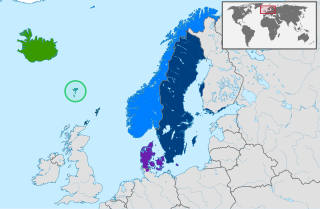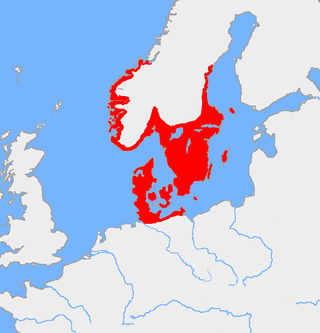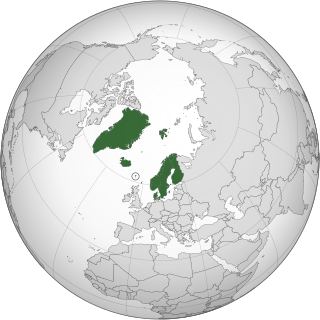Related Research Articles

Scandinavia is a subregion in Northern Europe, with strong historical, cultural, and linguistic ties between its constituent peoples. Scandinavia most commonly refers to Denmark, Norway, and Sweden. It can sometimes also refer more narrowly to the Scandinavian Peninsula. In English usage, Scandinavia is sometimes used as a synonym for Nordic countries. Iceland and the Faroe Islands are sometimes included in Scandinavia for their ethnolinguistic relations with Sweden, Norway and Denmark. While Finland differs from other Nordic countries in this respect, some authors call it Scandinavian due to its economic and other similarities.

The Scandinavian Peninsula is a peninsula located in Northern Europe, which roughly comprises the mainlands of Sweden, Norway and the northwestern area of Finland.

The Nordic Council is the official body for formal inter-parliamentary Nordic cooperation among the Nordic countries. Formed in 1952, it has 87 representatives from Denmark, Finland, Iceland, Norway, and Sweden as well as from the autonomous areas of the Faroe Islands, Greenland, and Åland. The representatives are members of parliament in their respective countries or areas and are elected by those parliaments. The Council holds ordinary sessions each year in October/November and usually one extra session per year with a specific theme. The council's official languages are Danish, Finnish, Icelandic, Norwegian, and Swedish, though it uses only the mutually intelligible Scandinavian languages—Danish, Norwegian, and Swedish—as its working languages. These three comprise the first language of around 80% of the region's population and are learned as a second or foreign language by the remaining 20%.

The North Germanic languages make up one of the three branches of the Germanic languages—a sub-family of the Indo-European languages—along with the West Germanic languages and the extinct East Germanic languages. The language group is also referred to as the Nordic languages, a direct translation of the most common term used among Danish, Faroese, Icelandic, Norwegian, and Swedish scholars and people.

A landscape is the visible features of an area of land, its landforms, and how they integrate with natural or man-made features, often considered in terms of their aesthetic appeal. A landscape includes the physical elements of geophysically defined landforms such as (ice-capped) mountains, hills, water bodies such as rivers, lakes, ponds and the sea, living elements of land cover including indigenous vegetation, human elements including different forms of land use, buildings, and structures, and transitory elements such as lighting and weather conditions. Combining both their physical origins and the cultural overlay of human presence, often created over millennia, landscapes reflect a living synthesis of people and place that is vital to local and national identity.

Scanian is a dialect of Swedish spoken in the province of Scania in southern Sweden.

The Nordic Bronze Age is a period of Scandinavian prehistory from c. 2000/1750–500 BC.

Fennoscandia, or the Fennoscandian Peninsula, is the geographical peninsula in Europe which includes the Scandinavian and Kola peninsulas, mainland Finland, and Karelia. Administratively, this roughly encompasses the mainlands of Finland, Norway and Sweden, as well as Murmansk Oblast, much of the Republic of Karelia, and parts of northern Leningrad Oblast in Russia.

Scandinavism, also called Scandinavianism or pan-Scandinavianism, is an ideology that supports various degrees of cooperation among the Scandinavian countries. Scandinavism comprises the literary, linguistic and cultural movement that focuses on promoting a shared Scandinavian past, a shared cultural heritage, a common Scandinavian mythology and a common language or dialect continuum, and which led to the formation of joint periodicals and societies in support of Scandinavian literature and languages. Nordism expands the scope to include Iceland and Finland.

Cultural geography is a subfield within human geography. Though the first traces of the study of different nations and cultures on Earth can be dated back to ancient geographers such as Ptolemy or Strabo, cultural geography as academic study firstly emerged as an alternative to the environmental determinist theories of the early 20th century, which had believed that people and societies are controlled by the environment in which they develop. Rather than studying pre-determined regions based upon environmental classifications, cultural geography became interested in cultural landscapes. This was led by the "father of cultural geography" Carl O. Sauer of the University of California, Berkeley. As a result, cultural geography was long dominated by American writers.
Nordic and Scandinavian Americans are Americans of Scandinavian and/or Nordic ancestry, including Danish Americans, Faroese Americans, Finnish Americans, Greenlandic Americans, Icelandic Americans, Norwegian Americans, and Swedish Americans. Also included are persons who reported 'Scandinavian' ancestry on their census. According to 2021 census estimates, there are approximately 9,365,489 people of Scandinavian ancestry in the United States.

Denis Edmund Cosgrove was a British cultural geographer. He taught at Oxford Polytechnic, Loughborough University, Royal Holloway, University of London, where he rose to become dean of the graduate school, and finally at the University of California, Los Angeles. In 1998, he received the prestigious Back Award from the Royal Geographical Society.
Don Mitchell is Professor of Cultural Geography at Uppsala University and Distinguished Professor Emeritus of Geography in the Maxwell School, Syracuse University. From an academic household in California, he is a graduate of San Diego State University (1987), Pennsylvania State University (1989) and received his Ph.D. from Rutgers University in 1992, working with Neil Smith. He taught at the University of Colorado, Boulder before joining Syracuse in the late 1990s.

Scania, also known by its native name of Skåne, is the southernmost of the historical provinces of Sweden. Located in the south tip of the geographical region of Götaland, the province is roughly conterminous with Skåne County, created in 1997. Like the other former provinces of Sweden, Scania still features in colloquial speech and in cultural references, and can therefore not be regarded as an archaic concept. Within Scania there are 33 municipalities that are autonomous within the Skåne Regional Council. Scania's largest city, Malmö, is the third-largest city in Sweden, as well as the fifth-largest in Scandinavia.

The Nordic countries are a geographical and cultural region in Northern Europe and the North Atlantic. It includes the sovereign states of Denmark, Finland, Iceland, Norway and Sweden; the autonomous territories of the Faroe Islands and Greenland; and the autonomous region of Åland.
Nordic art is the art made in the Nordic countries: Denmark, Faroe Islands, Finland, Iceland, Norway, Sweden, and associated territories. Scandinavian art refers to a subset of Nordic art and is art specific for the Scandinavian countries Denmark, Sweden and Norway.

North Germanic peoples, commonly called Scandinavians, Nordic peoples and in a medieval context Norsemen, were a Germanic linguistic group originating from the Scandinavian Peninsula. They are identified by their cultural similarities, common ancestry and common use of the Proto-Norse language from around 200 AD, a language that around 800 AD became the Old Norse language, which in turn later became the North Germanic languages of today.
Michelle Facos is an American writer and art historian.
Veronica della Dora is an Italian cultural geographer. She is Professor of Human Geography at Royal Holloway, University of London, where she is Director of the Social, Cultural & Historical Geography Group and Co-Director of the Centre for GeoHumanities.
References
- 1 2 3 4 Kenneth Olwig. "Kenneth R. Olwig: Calendar 2012, Research Projects, CV, Publications" (PDF). Archived from the original (PDF) on 2016-03-04. Retrieved 2013-06-13.
- 1 2 3 4 Kenneth Olwig. "Kenneth Olwig". Landscape Research Group. Retrieved 2013-06-13.
- 1 2 3 4 5 6 "Kenneth Olwig". Swedish University of Agricultural Sciences. Archived from the original on 2013-06-15. Retrieved 2013-06-13.
- ↑ Olwig 2003, pp. 211–212.
- ↑ Olwig 2003, p. 211.
- ↑ "Rod Such". Shimer College. Archived from the original on 2008-06-12. Retrieved 2013-06-13.
- ↑ "Early Entrant Program". Shimer College. Archived from the original on 2013-06-02. Retrieved 2013-06-13.
- ↑ Olwig 2003, p. 212.
- ↑ The morphology of a symbolic landscape: a geosophical case study of the transformation of Denmark's Jutland heaths circa 1750-1950. OCLC 4079419 – via Worldcat.
- ↑ Alix Cooper (2003). "Landscape, Nature, and the Body Politic: From Britain's Renaissance to America's New World. By Kenneth Olwig". Environmental History: 691–692. doi:10.2307/3985903. JSTOR 3985903.
- ↑ Olwig 1996.
- 1 2 David Matless (2003). "Landscape: Introduction". In Kay Anderson; et al. (eds.). Handbook of Cultural Geography. SAGE Publishing. p. 230. ISBN 076196925X.
- ↑ Olwig 1996, p. 633.
- ↑ Olwig 1996, p. 645.
- ↑ Olwig 1996, p. 646n1.
- ↑ Denis Cosgrove (1998). Social Formation and Symbolic Landscape. Univ of Wisconsin Press. p. 27. ISBN 0299155145.
- ↑ Sarah Whatmore; Steve Hinchliffe (2010). "Ecological Landscapes". In Dan Hicks; Mary C. Beaudry (eds.). The Oxford Handbook of Material Culture Studies. OUP Oxford. p. 441. ISBN 978-0199218714.
- ↑ John Wylie (2011). "Landscape". In John A. Agnew & David N. Livingstone (ed.). The SAGE Handbook of Geographical Knowledge. pp. 309–310. ISBN 978-1446209547.
- ↑ Elliott, John (September 2003). "Landscape Nature and the Body Politic: From Britain's Renaissance to America's New World (Book)". Southeastern Naturalist. 2 (3): 474.
- 1 2 Cosgrove 2003, p. 136.
- ↑ Cosgrove 2003, p. 137.